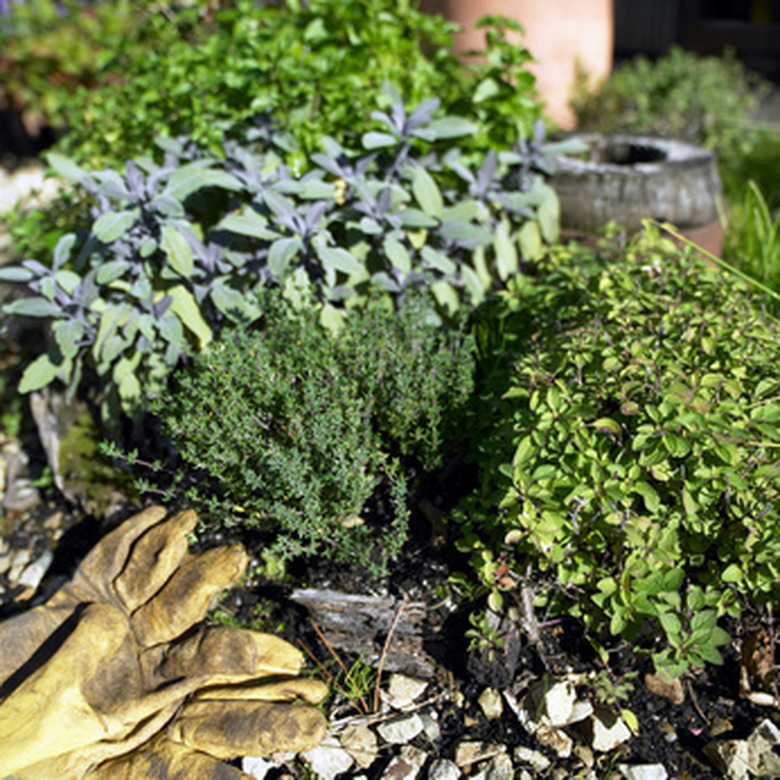How To Plant Seeds For Creeping Thyme In Texas
Things Needed
- Planting packs
- Seed-starting mix
- Creeping thyme seeds
- Spray bottle
- Hoe
- Landscaper's mix or bedding mix
- Shovel
- Compost
- Trowel
- Mulch
Creeping thyme (Thymus pulegioides) is a low-growing, spreading perennial herb that is frequently used as a lawn replacement thanks to its ability to withstand foot traffic. Once established, creeping thyme grows to form a dense 3- to 6-inch-high mat of low-growing greenery. Before planting creeping thyme in a Texas garden, you will need to prepare the planting area.
Planting Creeping Thyme Seeds
Step 1
Fill up planting packs with a quality seed-starting mix. Plant creeping thyme indoors about 6 weeks before the last spring frost date in your region.
Step 2
Mist the surface of the soil in the planting packs using a sprayer bottle until the mix is moist to the touch.
Step 3
Place two to three creeping thyme seeds onto the surface of the soil in the planting packs.
- Creeping thyme (Thymus pulegioides) is a low-growing, spreading perennial herb that is frequently used as a lawn replacement thanks to its ability to withstand foot traffic.
- Place two to three creeping thyme seeds onto the surface of the soil in the planting packs.
Step 4
Sprinkle no more than approximately 1/8 inch of seed-starting mix over the creeping thyme seeds.
Step 5
Place the planting packs where it's warm (between 60 and 70 degrees F) and bright. Provide between 8 and 10 hours of indirect light each day. Germination of creeping thyme seeds typically beings in 2 to 3 weeks. Keep the soil moist; mist with water as needed.
Step 6
Transplant the creeping thyme seedlings when they are approximately 2 to 3 inches tall.
Transplanting Creeping Thyme
Step 1
Choose a planting area for the creeping thyme that is in full sun to partial shade. Use a garden hoe to eliminate all weeds and their roots from the planting area. For areas in Central Texas where the soil is known as being hard and rocky, you may need to hand pull all the weeds.
- Sprinkle no more than approximately 1/8 inch of seed-starting mix over the creeping thyme seeds.
- Choose a planting area for the creeping thyme that is in full sun to partial shade.
Step 2
Amend the soil in the planting area. This is a very important step since the majority of soil throughout Texas is heavy and claylike. Spread out a 2- to 3-inch layer of compost over the entire planting area. Work the compost into the soil thoroughly, as suggested by the National Gardening Association.
Step 3
Spread out a 6- to 8-inch layer of either landscaper's planting mix or bedding mix over the growing area if the soil in your garden is too heavy or hard to cultivate, like areas around Houston. A raised planting bed can improve drainage and ensure the creeping thyme will not become water-logged.
Step 4
Create planting holes that are the approximately same width and depth of a cell in the planting packs. Space each of the holes between 6 and 8 inches apart.
- Amend the soil in the planting area.
- Spread out a 6- to 8-inch layer of either landscaper's planting mix or bedding mix over the growing area if the soil in your garden is too heavy or hard to cultivate, like areas around Houston.
Step 5
Remove a creeping thyme seedling from a planting pack. Push up from the base of a cell to pop out a creeping thyme seedling. Set the seedling into one of the previously created planting holes. Scoop soil in around the creeping thyme seedling to fill the hole full of soil.
Step 6
Water each of the creeping thyme seedlings with approximately 1 qt. of water. Then spread a 1 1/2- to 2-inch layer of pine bark, leaf mold or similar material for mulch around each of the creeping thyme seedlings. Mulching can protect the seedlings from the hot Texas sun, and keep moisture loss to a minimum.
- Remove a creeping thyme seedling from a planting pack.
